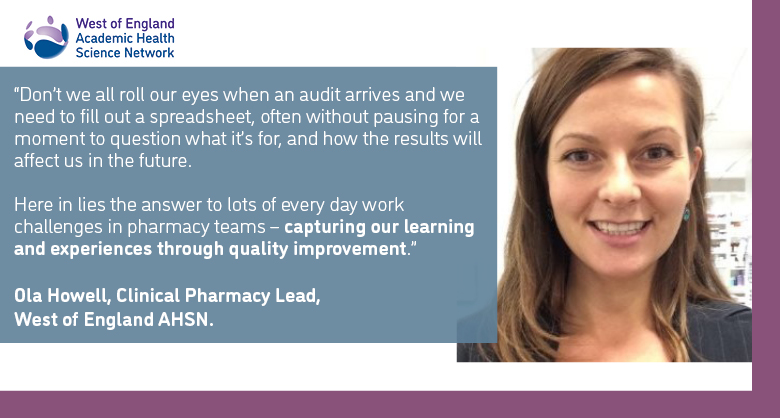
In this joint blog from Senior Project Manager, Chris Learoyd and Ola Howell, Clinical Pharmacy Lead at the West of England AHSN, we explore the value of Quality Improvement (QI) for pharmacy teams, why it hasn’t really been embedded so far and how pharmacy can get involved, including at our first-ever Pharmacy Showcase on 12 January.
First we hear from Chris…
As the Senior Project Manager for the Medicines Optimisation team at the West of England AHSN, but a former Physiotherapist, I won’t say it was always easy, but I have finally got my head around the wider challenges and issues with safe prescribing of medications.
The numbers are eye watering – circa 237 million medication errors occurring at some point in the medication cycle per year in the NHS in England and 66 million of these considered potentially clinically significant errors. Reducing medication errors can clearly have a significant and immediate effect on patient safety.
We know that as experts in medication management and optimisation, pharmacists and pharmacy technicians are ideally positioned in the healthcare system to improve current processes and reduce avoidable medication-related harm – and that QI approaches are vital to creating lasting change.
As every pharmacy team will know they are being positioned more centrally within healthcare services and have more clinical autonomy. Services such as the Discharge Medicines Service and Community Pharmacy Consultation Service provide a step change to embed pharmacy professionals as an important first point of call for healthcare information rather than traditional settings such as General Practice / Emergency Departments.
Introducing QI
Despite all this, pharmacists often lack the basic tools required to lead on or participate in QI initiatives as they’ve historically not been trained or required to perform QI projects. This is slowly changing, and here at the AHSN we’re working to drive adoption of QI approaches across pharmacy.
Here we’re handing over to Ola who gives details of the reasons for this, the impact and our new offer for pharmacy colleagues….
I’m a clinical pharmacist and over the last 12 years I’ve worked in a community pharmacy (very many of them), a General Practice (very briefly) and a hospital (or three, to be precise). Over those years I have met hundreds of pharmacy technicians and pharmacists determined to ensure their patients got the best (aka safest) care they could.
But I’ve never worked on QI before – what is it?
We are diligent, we are keen, and we are truly brilliant! No need to argue that. The thing that we are not good at is quality improvement. It is not that we don’t do it well, we simply don’t do it enough… And why would we? If you are anything like me and your registration number starts with 20*****, you would, most likely, had never been taught what QI is and how to do it well.
It wasn’t until the last couple of years that I started hearing about the QIPs, the PDSAs and the “driver diagrams”. Maybe I was not expected to know then, but I am now. (And there are masses of free resources on the West of England Academy website to help anyone embarking on QI work – but join our Pharmacy Showcase on 12 January to hear more about free, interactive and tailored support for your team).

Embracing QI to support our profession and wellbeing
Like never before, we are forced to do more and faster with less resources and time. We need to learn how to improve what we do in order to survive. And we need to do it now. The numbers are scary, with every fourth pharmacist reporting feeling ‘very stressed’ at work, mainly due to the increased demand for services and the lack of funding. That is 37% of community teams (up from 17% last year), 20% of hospital pharmacists (up from 10% in 2020) and 14% of GP and PCN pharmacists (up from 5% in 2020)[1]. I anticipate that the figures among pharmacy technicians follow a similar trend. Grim. Burnout alarm bells ringing all over the place.
When I asked around, I wasn’t surprised by the number of suggested solutions to various work problems we come across every day.
Not-a-surprise No. 1: We often know what goes wrong.
Not-a-surprise No. 2: We also often know a solution (or improvement) to the status quo. We sometimes even make that improvement ourselves!
For some reason, however, we rarely document the before and after and so are unable to prove our intervention has worked. “I am not wasting time on the data collection when I have so much to do”, I heard recently from a fellow pharmacist. “But your idea is brilliant! And it saves time, so if other people knew about this, the impact could be huge”, I reply. “Nah, too much effort”, I hear back. I bet this sounds familiar…
Don’t we all roll our eyes when an audit arrives and we need to fill out a spreadsheet, often without pausing for a moment to question what it’s for, and how the results will affect us in the future. Here in lies the answer – capturing our learning and experiences through QI.
Get involved
So come and meet us on the 12 January at our Pharmacy Showcase to hear about the projects our AHSN is involved in, meet the team, network with other pharmacy colleagues and learn more about a free, tailored Pharmacy for QI course coming in spring 2022.
[1] The Pharmaceutical Journal, PJ, November 2021, Vol 307, No 7955;307(7955)::DOI:10.1211/PJ.2021.1.114907
Posted on November 23, 2021 by Chris Learoyd, Senior Project Manager and Ola Howell, Clinical Pharmacy Lead, West of England AHSN


